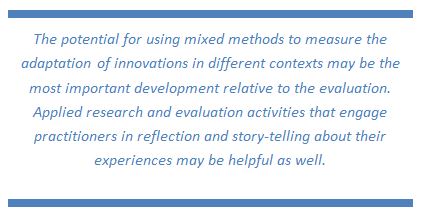This is the tenth post in a series about the Transformative Change Initiative (TCI) and is based on the 2014 TCI booklet. This post discusses the seventh guiding principle in the TCI Framework.
Using multiple forms of research and evaluation is important to scaling innovation. Comprehensive approaches to evaluation are also especially important when capacity building is undertaken, such as with TAACCCT. With respect to TAACCCT, comprehensive evaluation designs include performance evaluation wherein data are gathered to track and report on myriad education and employment indicators. Evaluations associated with TAACCCT also focus on program implementation, especially in conjunction with evidence-based programs and strategies.
Quasi-experiments or experiments may be valuable to assessing impact if circumstances allow for credible use of these designs. However, “rigorous” evaluation has limited utility if the data that are gathered lack validity, reliability, and utility.
Using multiple forms of evidence to inform practitioners and stakeholders about how implementation and spread is happening contributes to continuous improvement and scaling.[1]
How does evaluation expand the impact of your work? What should evaluators do to help practitioners to spread and sustain transformative change?
Debra Bragg, OCCRL director and endowed professor at Illinois, researches the transition to college by youth and adults, especially student populations that have not attended college historically
[1] Schorr, L. (2012, Fall). Broader evidence for bigger impact. Stanford Social Innovation Review. Retrieved from http://www.ssireview.org/articles/entry/broader_evidence_for_bigger_impact
